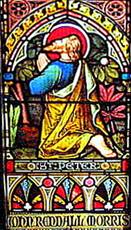

... God in the Arts - exploring symbols of the Christian faith
Editor: The Revd Michael Burgess (Parish Pump, UK) considers ‘and this month a trasure from the National Gallery at Trafalgar Square in London which houses one of the finest collections of European paintings in the world, with some 2,300 works spanning the centuries.
Still Life with Strawberries, Gooseberries and Asparagus: Adriaen CoorteSome weeks after Easter on the 6th Sunday of Easter is traditionally Rogation Sunday, when we give thanks for the fruits of the earth and pray for all who work on the land. Rural churches often celebrate nature’s cycle from seeds sown to crops harvested with Plough Sunday, Rogationtide, Lammas and Harvest.
Jesus in His teaching pointed out the miracle of that cycle in the seed – sown in the soil, but springing up to new life; a small beginning that becomes a great plant; a single seed that is multiplied.
The fruitfulness of natureis depicted in this beautiful, intimate painting that was given to the National Gallery some years ago by the Dutch collector, Willem van Dedem. It was painted in 1703 by Adriaen Coorte. We know little about him apart from the fact that he lived in Holland and has left us a garland of canvases, all displaying what has been called ‘a wondrous tenderness.’
This painting is an ordinary, unpretentious scene. There is no moral lesson here, no symbolism: simply a depiction of the beauty of creation in miniature. The bowl of strawberries and the bunch of asparagus lie on a stone ledge with some gooseberries and a plum. Each a gift of nature to enjoy and share, and to find there a token of God, the giver of all good things.
‘For everything there is a season,’ and in this painting, with Adriaen Coorte, we give thanks for this bounty of the earth and we pray for farmers and agricultural workers. But more than that – as the hymn tells us, ‘we thank thee then, O Father, for all things bright and good.’